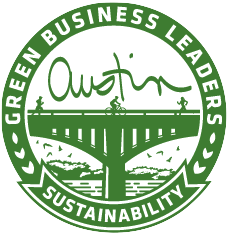The green building industry has exploded in recent years1, 2. However, the architecture and design fields within the industry continue to experience a diversity gap, with far fewer people of color and women employed in higher-wage positions such as engineer or architect3, 4. Women make up only 18% of American Institute of Architects (AIA) members, architects’ professional association5. People of color also remain significantly underrepresented6. Black people make up 13% of the U.S. population, but only 2% of AIA members7, 8. Latinos comprise 5% of AIA membership but are 18% of the general population7, 8.
EcoRise, the University of Texas School of Architecture (UTSOA), Austin Independent School District, and BLGY Architecture have teamed up to design and pilot an innovative Green Building Internship Program for Central Texas high school students. With plans to scale the program, the pilot’s mission is to facilitate an equitable pathway to green jobs that will promote climate and community resiliency via green building programs, localize climate change and empower student action, and create career opportunities for historically underrepresented students in the field of green building, including female students and students of color.
The pilot program is funded by Glimmer Austin and the City of Austin’s Office of Innovation. The first cohort of interns are members of Mr. John Sayce’s Scientific Research and Design Open-Ended Engineering Design course at Akins Early College High School in Austin, Texas. The student body at Akins High School is made up of 88.5% students of color and 62.1% economically disadvantaged students3. In Mr. Sayce’s class, students are learning about green building and sustainability through EcoRise’s Green Building Lessons for a Sustainable Future curriculum, which also prepares them to take the LEED Green Associate exam. To further apply what they have learned in the classroom, a diverse group of six students from Mr. Sayce’s class have the exciting opportunity to intern at BLGY to gain real-world work experience and learn more about the wide variety of professions associated with shaping the built environment.

2019–20 Green Building Interns during orientation at Akins High School.
Preparing internship hosts and interns to work with one another is an important step to ensuring student success. Just before winter break, UTSOA’s Assistant Professor Miriam Solis and two graduate students worked with EcoRise to orient the Akins students to the internship program and provide them with the tools that they need to have a successful experience in a professional workplace. In addition to covering workplace norms, architecture firm culture, and role-playing activities to help students navigate a variety of potentially challenging situations, the internship orientation included discussions about cultural capital and barriers that women and people of color often experience in a traditionally white, male-dominated workplaces. Students left more prepared and excited about the internship opportunity that lay ahead.

Dr. Miriam Solis of UTSOA training internship hosts from BLGY Architecture about the benefits of mentoring diverse students.
Later that day, Dr. Solis and EcoRise Deputy Director Abby Randall visited BLGY to facilitate a 90-minute lunch-and-learn for the four internship hosts who have signed up to mentor Akins students from January to May 2020. Students will work with BLGY professionals three times a month during the spring semester on the modernization of South Austin’s Blazier Elementary and Intermediate School. In addition to providing students with valuable opportunities to develop skills and knowledge to pursue professions related to green building, the internship hosts brainstormed how to navigate potential challenges and learned they play a crucial role in mentoring interns through career advice and modeling professional and social behaviors. Exposure to career pathways and mentorship in high school affects students’ likelihood to pursue a career in the industry9.
The lunch-and-learn included an engaging discussion about community cultural wealth.10 The concept holds that people of color possess skills, abilities, and knowledge rooted in their experiences with social marginalization. These attributes are typically overlooked due to deficit thinking. Mentors engaged in a community cultural walk exercise to reframe cultural capital in a way that acknowledged these attributes as strengths. They considered ways to recognize and build on these strengths to enhance learning and ensure a positive internship experience. Being open to the unique experiences and knowledge that each student can bring to the internship reduces cultural communication barriers and creates a two-way learning experience for the mentor and intern.
Another major way to reduce barriers for students, and further increase opportunity and access to green careers is by offering paid internships11. Akins students – as well as other high school students of color from across the Austin area – will have an opportunity to build on their course-based internship experience through a paid summer internship with local architecture firms and municipal offices. By providing paid internships, as well as transportation to and from internship sites, EcoRise’s Green Building Internship Program aims to further reduce barriers for students whose families experience financial insecurity and don’t have the privilege of being able to intern or work without compensation for weeks or months at a time.
Visit the Green Building page to learn more about this program or get involved today. You can also follow the first cohort of interns on Instagram this spring: @ecorise_greenbuilding.
Endnotes:
-
Van Steenwyk, Jason, Why Is Green Building Design Surging Right Now?, Buildium, May 25, 2017, https://www.buildium.com/blog/green-building-design/
-
Prum, Darren A. and Tetsuo Kobayashi, Green Building Geography across the United States: Does Governmental Incentives or Economic Growth Stimulate Construction?, Real Estate Law Journal 43, no. 1 (2014).
-
Roberts, Jamie and Hope Shinn, Diversity in STEM, 2018
-
Siemiatycki, Matti, The Diversity Gap In The Public–Private Partnership Industry: An Examination Of Women And Visible Minorities In Senior Leadership Positions, Annals of Public and Cooperative Economics 90, no. 2 (2019): 393–414.
-
Cimino, Steve, Diversity: Not a ‘Women-Only Problem’ – AIA, May 27, and 2016, https://www.aia.org/articles/13086-diversity-not-a-women-only-problem:26.
-
NCARB – National Council of Architectural Registration Boards, NBTN 2017 Demographics, June 28, 2017, https://www.ncarb.org/nbtn2017/demographics.
-
U.S. Census Bureau, QuickFacts, 2019, https://www.census.gov/quickfacts/fact/table/US/PST045219
-
Liao, Alice, Increasing Diversity and Inclusion in Architecture: Barriers to Entry, Architect, May 13, 2019, https://www.architectmagazine.com/practice/increasing-diversity-in-architecture-barriers-to-entry_o.
-
Equity and Architecture Research Project, Equity by Design [EQxD]: Minimizing Barriers to Maximize Potential for Succes, 2018, http://eqxdesign.com/.
-
Yosso, Tara J., Whose culture has capital? A critical race theory discussion of community cultural wealth, 2005, http://dx.doi.org/10.1080/1361332052000341006.
-
Stanford Social Innovation Review, Reimagining the Internship to Promote Racial Equity, July 9, 2019, https://ssir.org/articles/entry/reimagining_the_internship_to_promote_racial_equity.




